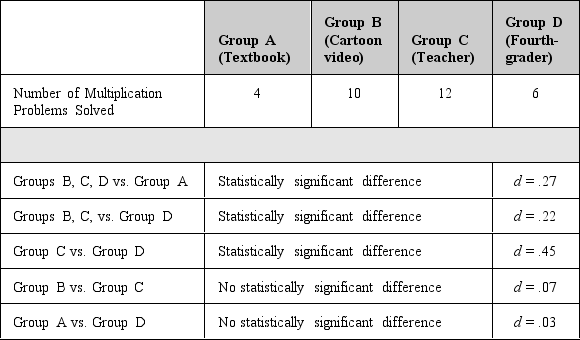Essay
Dr.Phillips is a cognitive-developmental psychologist who studies how children learn mathematical principles.His current interest is in studying how children learn multiplication.He recruits 54 second-graders who have not yet learned how to multiply numbers to participate in his study.He is curious as to whether different teaching styles lead to better mastery of the subject.One condition (A)involves having students read a chapter on multiplication from their textbook.One condition (B)involves having students watch a video of cartoon characters explaining multiplication.One condition (C)involves having students being taught multiplication from a teacher.One condition (D)involves having students being taught multiplication by a fourth-grader.In all conditions,participants spend 30 minutes learning the fundamentals of multiplication and are then given the same 15-question multiplication test.The number of questions answered correctly is recorded.The data are below.

-Name two ways that Dr.Phillips could avoid selection threat when he is assigning participants to conditions and explain why each of these methods avoids selection threat.
Correct Answer:

Verified
Students should provide two ways to avoi...View Answer
Unlock this answer now
Get Access to more Verified Answers free of charge
Correct Answer:
Verified
View Answer
Unlock this answer now
Get Access to more Verified Answers free of charge
Q2: What is the primary difference between pretest/posttest
Q17: Explain the difference between full counterbalancing and
Q35: The ability for a study to reveal
Q39: An independent-groups design is also known as
Q41: A threat to internal validity occurs only
Q42: <br>Dr.Lonsbary is a cognitive psychologist who is
Q44: Which of the following is a threat
Q44: <br>Dr.Lonsbary is a cognitive psychologist who is
Q45: Which of the following provides information about
Q49: Explain why experiments are better than your